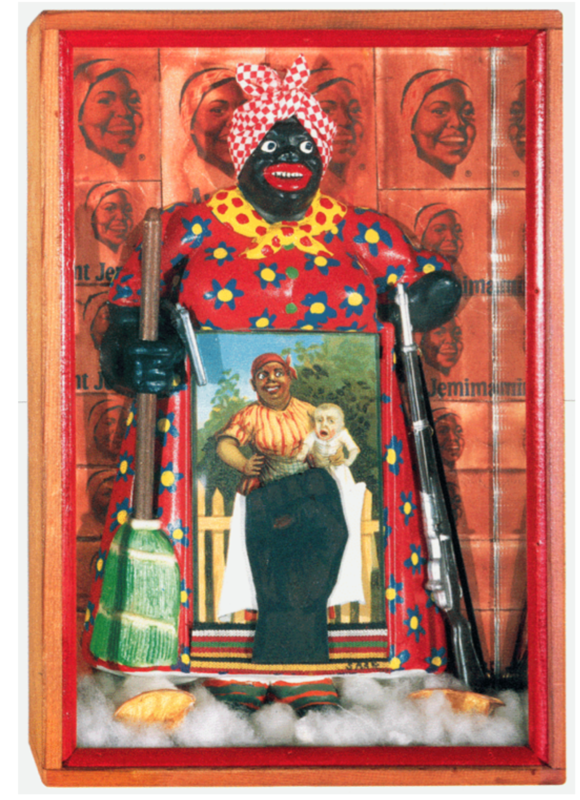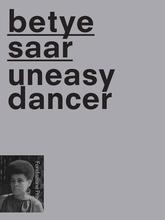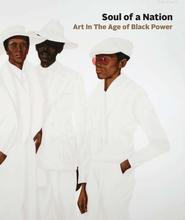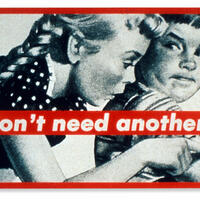More about The Liberation of Aunt Jemima
- All
- Info
- Shop

Contributor
Betye Saar’s The Liberation of Aunt Jemima was such an impactful black feminist piece that the legendary activist Angela Davis referred to it in a speech as the piece of art that sparked the Black women’s movement.
Saar came up with the idea for this iconic work in response to a themed show in which she was invited to take part. The show was at a Berkeley community center called the Rainbow Sign, located nearby the Black Panther headquarters, and the theme of the show was black heroes. In what is now classic Saar form, she decided to use collected objects to create her own heroine out of a racist “mammy” figure she had found at a Los Angeles flea market.
The figure was one of a medley of objects that Saar collected beginning in 1967 after seeing a Joseph Cornell showing in LA. By 1972, she had been collecting objects that caught her eye for five years, many of them derogatory and racist. When she set out to create her heroine for the Rainbow Sign show, she had collected a whole set of derogatory racist objects, inclunding ”postcards, a cigar-box label, an ad for beans, and Darkie toothpaste.”
The mammy stereotype is rooted in the enslaved African American women who did domestic work in white homes. The figure, like many mammy figures, was sold as a kitchen appliance. The figurine Saar used had a notepad holder for an apron and held a pencil in the woman’s hand. Saar took this twisted concept and flipped it on its head in an act of empowerment. She placed a gun in one hand and a grenade in the other. She then replaced the notepad with a postcard of a black woman holding a mixed race baby. The postcard drew on the historical sexual exploitation and rape of enslaved peoples by white masters. As a backdrop to the figure, she collaged a black power fist and a set of Aunt Jemima pancake labels--the mammy stereotype is the same caricature in Aunt Jemima pancake mix. Saar transformed the figurine, and the whole concept of mammies, into an empowered revolutionary. She said, “I was recycling the imagery, in a way, from negative to positive, using the negative power against itself.”
Moving forward, many of her pieces would challenge racists myths and stereotypes. Looking back at this piece, Saar recently said, ““I feel that The Liberation of Aunt Jemima is my iconic art piece. I had no idea she would become so important to so many. The reason I created her was to combat bigotry and racism and today she still serves as my warrior against those ills of our society.”
As of June 17th, 2020, Quaker Oats, the owners of the Aunt Jemima brand, finally announced that they will change their name and image 130 years after its inception.
Sources
- Betye Saar, Awardee Video for the California African American Museum by Ricardo Genzon and Ruth Robinson. 2011. Vimeo, 2018. https://vimeo.com/40370355.
- “Betye Saar | American Artist and Educator | Britannica.” Encyclopedia Brittanica. Accessed June 16, 2020. https://www.britannica.com/biography/Betye-Saar.
- Félix, Doreen St., and Peter Schjeldahl. “MOMA's Heady Introduction to Betye Saar, ‘The Conscience of the Art World.’” The New Yorker, October 24, 2019. https://www.newyorker.com/culture/culture-desk/momas-heady-introduction…
- Griffin, Jonathan. “An Interview With Betye Saar,” June 12, 2020. https://www.apollo-magazine.com/the-way-i-start-a-piece-is-that-the-mat….
- Hsu, Tiffany. “Aunt Jemima Brand to Change Name and Image Over 'Racial Stereotype',” June 17, 2020. https://www.nytimes.com/2020/06/17/business/aunt-jemima-racial-stereoty….
- Saar, Betye. “Influences: Betye Saar,” September 27, 2016. https://frieze.com/article/influences-betye-saar.
- Sayej, Nadja. “Betye Saar: the Artist Who Helped Spark the Black Women's Movement,” October 30, 2018. https://www.theguardian.com/artanddesign/2018/oct/30/betye-saar-art-exh….














